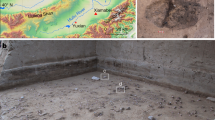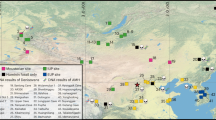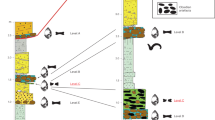Abstract
The geographical position of the island of New Guinea suggests that it may have been an early staging post in the Pleistocene settlement of Australia from the Indonesia–Indochina region. Previous data have not supported this, as archaeological sites 35,000 to 40,000 years old occur in southern Australia1,2, whereas the earliest previously known in Papua New Guinea is 26,000 years old3–5. We now report evidence that the north coast of Papua New Guinea was occupied at least 40,000 years ago. Sahuland, which is the greater land area of Australia and New Guinea plus their connecting continental shelf exposed as land when Pleistocene sea levels were lower than now6,7, was occupied by humans in several widely separated areas at that time. A distinctive ‘waisted axe’ culture appears to have existed in New Guinea and probably in Australia in the Late Pleistocene, but antecedents are not yet known from east and southeast Asia. There is evidence for hafting of these tools at a date which is earlier than known elsewhere in the world.
This is a preview of subscription content, access via your institution
Access options
Subscribe to this journal
Receive 51 print issues and online access
$199.00 per year
only $3.90 per issue
Buy this article
- Purchase on Springer Link
- Instant access to full article PDF
Prices may be subject to local taxes which are calculated during checkout
Similar content being viewed by others
References
Bowler, J. M. in The Origin of the Australians (eds Kirk, R. L. & Thorne, A. C.) 55–77 (Australian Institute of Aboriginal Studies, Canberra, 1976).
Pearce, R. H. & Barbetti, M. Archaeol. Oceania 16, 173–178 (1981).
Hope, J. S., Golson, J. & Alien, J. J. hum. Evol. 12, 37–60 (1983).
White, J. P., Crook, K. A. W. & Ruxton, B. P. Proc. prehist. Soc. 36, 152–170 (1970).
Gillieson, D. S. & Mountain, M. J. Archaeol. Oceania 18, 53–62 (1983).
Chappell, J. in The Origin of the Australians (eds Kirk, R. L. & Thorne, A. G.) 11–22 (Australian Institute of Aboriginal Studies, Canberra, 1976).
Birdsell, J. B. in Sunda and Sahul (eds Allen, J., Golson, J. & Jones, R.) 113–167 (Academic, London, 1977).
Veeh, H. H. & Chappell, J. Science 167, 862–865 (1970).
Chappell, J. Bull. Geol. Soc. Am. 85, 553–570 (1974)
Bloom, A. L., Broecker, W. S., Chappell, J., Matthews, R. K. & Mesolella, K. J. Quat. Res. 4, 185–205 (1974)
Chappell, J. Search 14, 99–101 (1983).
Chappell, J. Archaeol. Oceania 17, 69–78 (1982).
Chappell, J. & Shackleton, N. J. Nature (in the press)
Fleming, S., Thermoluminescence Techniques in Archaeology, 58–80 (Clarendon, Oxford, 1979).
Johnson, R. W., Mackenzie, D. E., Smith, I. E. & Taylor, G. A. M. in The Western Pacific (ed. Coleman, P. J.) 523–533 (University of Western Australia Press, 1973).
Parkinson, R. H. R., Dreissing Jahre in der Sudsee, 405–407 (Strecker & Schroder, Stuttgart, 1907).
Bulmer, S. Oceania 34, 246–265 (1964).
Lampert, R. J. Rec. Austr. Mus. (Sydney) No. 135 (1983).
Leach, E. R. Man, 38, 161–163 (1938).
Chard, G. S. Northeast Asia in Prehistory (University of Wisconsin Press. 1974)
Author information
Authors and Affiliations
Rights and permissions
About this article
Cite this article
Groube, L., Chappell, J., Muke, J. et al. A 40,000 year-old human occupation site at Huon Peninsula, Papua New Guinea. Nature 324, 453–455 (1986). https://doi.org/10.1038/324453a0
Received:
Accepted:
Issue Date:
DOI: https://doi.org/10.1038/324453a0
This article is cited by
-
More than a decade of genetic research on the Denisovans
Nature Reviews Genetics (2024)
-
65,000-years of continuous grinding stone use at Madjedbebe, Northern Australia
Scientific Reports (2022)
-
Pleistocene Water Crossings and Adaptive Flexibility Within the Homo Genus
Journal of Archaeological Research (2021)
Comments
By submitting a comment you agree to abide by our Terms and Community Guidelines. If you find something abusive or that does not comply with our terms or guidelines please flag it as inappropriate.



